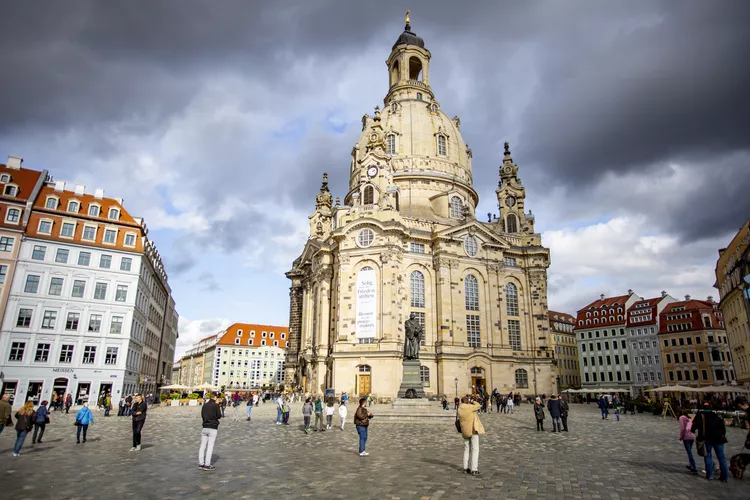The signature landmark of Dresden is the Dresdner Frauenkirche, the Church of Our Lady. It is one of the most talked-about German buildings in the recent past and a must-see site in Dresden. Let’s take a look at the history of this beloved church and find out how to visit Dresden’s Frauenkirche.
History of the Frauenkirche
The first Catholic church on this site was built in the 11th century in Romanesque style; however, it became Protestant during the Reformation. In the 18th century, the entire building was replaced with a much larger Baroque structure. This design features one of the largest domes in Europe at 315 feet (96 meters) high called die Steinerne Glocke or “Stone Bell.”
In 1849, the church was at the center of May Day (Labor Day) protests. The fighting lasted for days around the church before the rebels were forcibly put down and arrested.
During World War II, air-raids devastated most of Dresden, destroying many historic buildings and churches. Among them was the Frauenkirche, which collapsed into a 42 feet (13 meters) high pile of rubble amid 650,000 incendiary bombs that surged the temperature around the church to 1,830 degrees F (1,000 degrees C). The ruins were left untouched for 40 years, serving as a poignant reminder of the destructive powers of war.
In the 1980s, the ruins became a site of the East German peace movement. Thousands gathered here to protest the regime of the East German Government on the anniversary of the bombing. By 1989, tens of thousands of protesters had gathered here, and the wall between East and West Germany finally fell.
Due to the increasing decay of the ruins and criticisms of it being an eyesore, the painstaking reconstruction of the Frauenkirche began in 1994 after reunification. The rebuilding project was financed almost entirely by private donations from all around the world. It took 11 years and over 180 million euros to complete the reconstruction in 2005, just in time for the 800th anniversary of Dresden.
Although some critics argued that the funds could have been better allocated to social programs like new housing, the Frauenkirche has become a symbol of hope and reconciliation, attracting millions of visitors every year. The church also prioritizes its peace work, which is reflected in various tributes and active initiatives today.
Re-Building
Original stones charred from the fire were carefully salvaged from the ruins, combined with new, lighter-colored stones—resulting in an architectural mosaic of past and present. The Frauenkirche was reconstructed using the original plans from 1726, with architects determining the position of each stone from its original locale in the rubble.
The vibrant murals inside the church and the artistically carved oak doors were recreated with the help of historical photographs. Furthermore, the golden cross on top of the church was crafted by a British goldsmith, whose father was an Allied pilot involved in the air-raids over Dresden.
:max_bytes(150000):strip_icc():format(webp)/ChurchofOurLady-4-4db749f59343447693093ffd998a5f6e.jpg)
Attractions
For those who are up for a hike, consider ascending to the dome. This steep climb rewards visitors with unparalleled views of the reconstructed city center and riverfront.
For more in-depth knowledge about the church, you may want to join a guided tour. These tours are available free of charge every day, though most are conducted in German. For tours in a different language, inquire at their ticket office. Should you miss the tour time or require a different language, audio guides are available for two and a half euros in various languages.
Visitor’s Information
Address: Frauenkirche, Neumarkt, 01067 Dresden
Getting there by tram or bus:
- Altmarkt tram lines 1, 2, 4, 12
- Pirnaischer Platz tram lines 3, 6, 7 and bus line 75
Entrance: Free (To climb up to the dome costs eight euros)
Hours: Weekdays between 10 a.m. to noon and 1 p.m. to 6 p.m. Weekend hours depend on scheduled events.
Organ Recitals and Services:
- Organ recitals: Monday to Friday at noon, evening devotion at 6 p.m., Sunday service, or one of the roughly 40 scheduled concerts a year
- Service in German: Daily, 6 p.m.; Sunday 11 a.m. and 6 p.m.
- Service in English: Every third Sunday in a month, 6 p.m.
Viewing Platform: Note that the platform is only accessible weather permitting.
- November to February: Monday to Saturday 10 a.m. to 4 p.m.; Sunday 12:30 p.m. to 4 p.m.
- March to October: Monday to Saturday 10 a.m. to 6 p.m.; Sunday 12:30 p.m. to 6 p.m.
Photos: Please note that taking photos or filming is not allowed inside the church.




